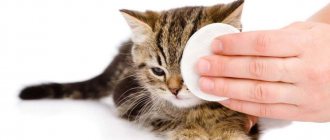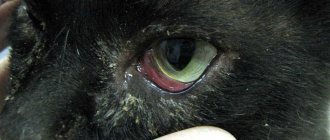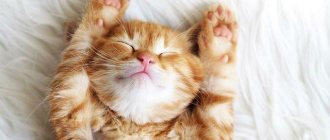Pathological causes
One of the main signs of health problems in warm-blooded animals is elevated body temperature.
In cats, it can be measured with high accuracy using a special rectal thermometer.
However, a caring owner can determine hyperthermia without special tools, simply by touching the nose and ears of his cat - if they are hot, then this may be a sign of ill health.
The normal body temperature for humans is approximately 36.6 degrees Celsius. Of course, its indicators may vary depending on the time of day, the physical condition of the person at the time of its measurement and many other factors.
The physiological body temperature of cats is higher than that of humans, averaging 38 °C. In this regard, a cat’s ears will almost always seem hotter than their own body to a person.
It is worth mentioning separately about hairless cat breeds, for example, the same Sphynx. They may appear much hotter than a furred animal.
This is primarily due to the fact that representatives of hairless breeds spend much more energy due to their inherent accelerated metabolism.
Therefore, despite the fact that sphinxes may seem very hot to the touch, in most cases this is a physiological norm for the animals themselves.
Of course, an experienced cat lover can determine by touch that his pet’s ears are much hotter than usual. And, naturally, such a phenomenon cannot but cause concern for the owner.
Hot ears alone cannot serve as a reliable sign of illness in an animal. The cat's health status should be assessed using a whole range of different indicators.
So, when an animal is sick, in addition to hot ears, the following signs may be present:
- change in the color of the auricle (during illness, it acquires a bright red tint); the owner can notice redness of the ear with the naked eye
- increased temperature in the armpits and oral cavity;
- nose that is hot and dry to the touch;
- lethargy, apathy of the animal, refusal to eat.
If, along with hot ears, the cat has at least a few of the above signs, then only this is the basis for suspicion of the pet’s ill health.
There are many reasons why a cat's ears become hot. However, all of them can be combined into two groups:
- Physiological reasons. The temperature of the ears is influenced by many external factors, for example, being in a hot and stuffy room, or prolonged physical activity of the pet. Sometimes ordinary stress can provoke such hyperthermia. Newborn kittens and pregnant cats always have very hot ears.
- Pathological reasons. The most common among them are: infection with ear mites;
- colds;
- infectious diseases of the ears, for example, otitis media;
- injuries and hematomas;
- viral infections.
Pathologies, in addition to elevated ear temperature, always manifest themselves with additional symptoms, which you should pay attention to first:
- Ear mite. Infection of cats with ear mites, which in veterinary practice is called otodectosis, is a fairly common phenomenon. It is worth noting that otodectosis can affect only one ear - in this case, the symptoms will be characteristic of only one ear. The disease is accompanied by: severe hyperthermia of the ears;
- presence of foul-smelling dark discharge from the ears;
- the formation of ulcers on the inner surface of the ear;
- restless behavior of the pet, expressed in attempts to comb the ears. The owner of the animal can see with the naked eye not the ear mites themselves, but their metabolic products
- change in ear color (its inner side becomes red), local hyperthermia;
- increased ear temperature;
- lethargy;
If a cat has hot ears, then he should have his auricle examined, the condition of which can be used to judge whether the animal has a particular pathology.
You can do this as follows:
- It is necessary to calm the pet. It is impossible to conduct an examination when the cat is in an aggressive or excited state.
- If touching the ear causes pain to the animal, it must be secured in a diaper or towel to protect itself from sharp claws.
A protective bag is a convenient device that will protect the owner from the sharp claws of the pet when examining it. - The examination begins from the outside of the ear, it is noted whether there are any ulcers, scratches, scratches, or hair loss on it.
- Next, the inside is inspected; to do this, the animal’s ear should be slightly bent.
- Under no circumstances should you try to insert foreign objects deep into your cat's ear. This is fraught with damage to the hearing aid, infection, and this manipulation can cause an attack of acute pain in the pet.
- When examining the inside of the ear, you should pay attention to the color of the skin, the presence of discharge, ulcers and microtraumas.
We invite you to familiarize yourself with: Breed of chickens Loman Brown description crosses
It is almost impossible to reliably find out whether a cat’s general body temperature is elevated by external signs. To do this, you should use the appropriate medical instruments - a thermometer.
Measure your pet's temperature like this:
- It is necessary to secure the animal with a towel or diaper.
- The tip of the thermometer must be lubricated with Vaseline or baby cream.
- The tip of the thermometer is placed into the cat's anus using rotational movements to a depth of no more than 1 cm.
- During insertion of the thermometer, you should hold your pet tightly, since this procedure is usually very unpleasant for him.
- When measuring temperature, the thermometer should be at an angle of approximately 30 degrees.
- After measurement, the thermometer must be washed and disinfected.
Measuring a cat's temperature takes on average about 2 minutes.
Once I had the opportunity to measure the temperature of my cat. According to the description, this is a simple matter, but in reality the process is very complex. First, you need an assistant. We kept the cat together; I definitely wouldn’t have been able to handle it alone, because the animal definitely wouldn’t lie quietly with a thermometer.
Secondly, we were unable to wrap the hind legs securely right away, since we had to insert a thermometer under the tail, and we additionally wrapped them after inserting the thermometer. And thirdly, we also had to wrap up the cat’s face because she tried to bite. The animal’s suffering was not in vain, because the cat was really sick.
Her temperature was closer to 40 degrees, and I quickly took her to the vet.
If the cat has no other symptoms other than hot ears (that is, there is no discharge from them, normal behavior and appetite remain), then there is no need to see a doctor.
If any other symptoms are observed, which were mentioned in this article above, then this is a reason to contact a veterinarian as soon as possible. This is especially true for otitis, since complications of this disease can lead to extremely sad consequences for the animal.
If it is determined that the cat has an elevated body temperature, then it must be brought down before visiting the veterinarian.
Usually, the same medications are used for this as for people, but independently calculating a safe dosage for a pet can be extremely problematic.
Therefore, for these purposes, safe methods should be used to eliminate hyperthermia in the animal. These include the use of:
- Echinacea tinctures. Echinacea tincture must be mixed with water at the rate of 1 drop per 1 kg of cat weight. Pour into the animal’s throat using a syringe. If you have a fever, you can give your cat echinacea tincture
- Regidron - a saline solution to prevent dehydration at high temperatures in an animal. One sachet must be dissolved in 1 liter of water and pour 5 ml of solution into the cat’s mouth using a syringe every 2 hours. Drinking Regidron at a temperature will protect the animal from dehydration
- Physiological cooling. At high temperatures, you can cover the cat with a wet towel or wrap ice in a dry diaper and apply it to the pet’s inner thighs. This method effectively reduces high fever without the use of pharmacological agents.
Hot ears in a cat do not always mean pathology; in most cases, this is a completely physiological condition of the animal. However, if other symptoms are also observed, then this is a reason to seek veterinary help. Moreover, in case of some diseases, for example, otitis media, this must be done immediately, since the complications it causes are very dangerous for the life and health of the pet.
Today, as usual, you started petting your pet and discovered that the cat has hot ears. You immediately have a question: why and is this normal? There are various reasons why the temperature of a cat's ears may change. They can be either completely harmless or as a consequence of serious problems with the health of the animal. Let's look at the answer to this question.
We suggest you familiarize yourself with: Eye drops for cats and kittens against tearing, inflammation and infectious diseases
What to do if the cat or kitten is hot?!
All of the above applies to kittens, but due to the development of the body, all sores are much more severe. The baby's immunity is fragile due to hormonal changes. So if the kitten is hot, the kitten has a hot nose
, and when measuring the temperature you see frightening numbers on the thermometer, you can’t hesitate, the baby needs to be shown to the doctor.
Excessively hot paws on a kitten
also indicate an elevated temperature.
So, you discovered that the cat has a hot
nose,
you noted an elevated temperature -
what to do
next?
The animal should be shown to a specialist as soon as possible.
In order not to drag a sick cat to the clinic, the best option is to call a veterinarian at home. The veterinarian comes to your home with all the necessary tools and medications to provide the necessary veterinary care.
As you know, animals cannot speak. Therefore, it is difficult to understand when they get sick. One of the symptoms indicating an increase in temperature is hot ears in the cat.
When is this normal?
- Activity during games.
- Condition after sleep, when the pet slept near a heating device or basked in the sun.
- Established hot weather in summer, stuffy room.
Playing kitten
In these cases, there is no reason to worry - the body temperature, and, consequently, the ears will soon return to normal. But if in doubt, measure the cat’s body temperature rectally.
Attention! Normal values for a kitten are 39-39.6°, the norm for adult animals is 38-39°, for hybrid hairless breeds – 40-41°.
Manifestations of stress, fear, and excitement can also cause a cat’s temperature to rise and make his ears hot. It is necessary to examine the animal and determine the factor that caused this standing:
- Moving, separation from the owner.
- Fright (repair work).
- Noises and smells (presence of strangers in the house: noisy guests, festive events, increased attention from children).
- The appearance of a new animal in the apartment.
If it is impossible to eliminate the cause of anxiety, you should ensure that your small pet gets used to the current situation as quickly as possible. Frequent or prolonged exposure to stress can provoke depression, which turns into a serious illness.
If a cat has hot not only ears, but also a nose, then there may be serious health problems.
- The cat's body fights a viral infection
Various intestinal disorders
Ear mites (symptoms and treatment we discussed above)
There are a lot of infectious diseases that occur hidden and can only be identified by a specialist.
External and internal inflammatory processes
The cat may be injured, but if the damage is internal, you will not be able to determine it yourself
How to determine if your pet is sick
The cat has become lethargic, stopped eating, does not go to the toilet (or tries but fails), sneezes, and has a depressed and apathetic state. By measuring the temperature, you can determine whether there are inflammatory processes in the animal’s body.
What to do?
If your pet's behavior has changed dramatically. Visit a veterinarian, or make a house call, if possible. Don't let your pet's condition take its course. Help him and he will be grateful to you.
Let's sum it up
Clean, hot ears with a warm, moist nose are no cause for concern. The cat is active and that means everything is fine. Well, if hot ears are accompanied by a dry, hot nose and a general increase in temperature, and the above symptoms also appear, then he will not be able to cope without your help.
Now you know when to worry about your cat's hot ears and when not to.
Hot cat ears?
/ Cats / Health and illness / Does your cat have hot ears?
They say a cat has nine lives. But, despite its vitality, we should not forget that this is a living creature, and it is common for any living creature to get sick. A pet requires care and attention, which is why it is necessary to pay attention to why the cat has hot ears.
This symptom does not always indicate the presence of a disease in the animal’s body. And yet, when, during the next lull in your arms, you notice changes in the temperature of your body or ears, you need to find out the reason for this, carry out a home inspection and learn how to properly care for your hearing organs.
Compared to the human body, cats and dogs have a much higher body temperature.
The normal temperature of the tailed purr is from 38 to 39.5 degrees.
Cats' ears are covered with very thin and short hair, and the capillaries are located very close to the skin, so many people feel that their temperature is slightly elevated.
But sometimes this can be a sign of an incipient illness, which certainly needs to be treated. Although scientists claim that cats have the ability to self-heal, it is better not to take risks, but to recognize the cause of your pet’s unusual condition.
The temperature of the ears increases in the case of:
- inflammatory process in the body;
- gastrointestinal diseases;
- infectious disease;
- bladder stones;
- various injuries;
- ear mite
Whatever the cause, they all require treatment.
A cat will never tell you how it is feeling in human words, but you can do some simple research yourself at home:
- First, inspect the ears for the presence of foreign bodies. Carry out this manipulation very carefully because the ears of cats are a complex and delicate organ that requires careful handling. If any objects are found, it is better to remove them at a veterinary clinic.
- Observe the dynamics of activity. If a cat has some kind of disease, he usually behaves lethargically or, on the contrary, becomes irritable. In any case, the kitten's behavior will change.
- Be sure to take your temperature rectally. Please note that the normal temperature for cats is 38 – 39 degrees.
If the above indicators are normal, then there is no need to worry, everything is fine with the animal. Perhaps the kitten was nervous, played actively, or overheated in the sun. The body temperature rises for a while, and as a result, your cat has hot ears. Otherwise, consult a doctor.
Once you have determined that there is still a problem, you need to solve it. The best way is to contact a veterinarian. But how can you help a friend if you can’t visit a doctor?
There are several useful tips to help stabilize your kitten's normal condition.
Nutrition
This factor greatly influences the quality and quantity of years allotted to the cat.
Therefore, if you see, along with elevated temperature, stool upset, vomiting or other symptoms associated with the gastrointestinal tract, then first of all you need to change your diet. It happens that even with overeating or undereating, the temperature of the nose and ears noticeably increases.
Clever kittens can generally pick up and eat anything. Watch your pet, see how much he has eaten, what food benefits him and makes him calmer.
Perhaps you have introduced something new to your diet, in which case you will have to abandon the innovations. You can create an individual diet, but only together with a doctor.
Stress
Our mustachioed and striped friends are very conservative. Therefore, the slightest changes in the usual way of life can traumatize their psyche, which is why the animal can behave, at least strangely.
We suggest you read: Why does a cat not eat, drink or go to the toilet?
If your cat has become unusually aggressive or, on the contrary, lethargic and apathetic, does not want to play, but with the tenacity of a Spartan he shits in your favorite shoes, then perhaps the cat is very worried.
There are many factors that contribute to a cat’s increased irritability:
- change of decor in the house;
- the appearance of guests on its territory, both people and animals;
- travel or relocation;
- change of owner or prolonged absence.
Various noises can also cause stress in a cat, for example, the sounds of firecrackers or other pyrotechnics on holidays. What to do? Stabilize the psychological state. Here, you don’t need to panic yourself, since the animals feel it well, you just need to help them adapt and get used to the new environment.
Infections
Cats, especially at a young age, are very susceptible to all kinds of infectious and viral diseases. First of all, it is important to pay attention to the symptoms:
- refusal to eat and drink;
- dry, hot nose, as well as hot ears;
- peeling of the skin;
- the appearance of bald spots on the head and body of the animal;
- heat;
- blood in the urine, difficulty urinating or stopping completely.
Under such circumstances, the animal must be taken to a veterinarian. If the temperature is elevated, you can normalize it by using a cool towel dipped in water or wrapping ice in it. Another way is to wipe the paw pads every hour with a solution of 9% vinegar in water, in a ratio of 1:2.
Never give antipyretic drugs without a doctor's prescription!
Drinking plenty of water will help here; it is advisable to give the kitten water yourself, because he may, due to his weakness, refuse to drink, and this is very important. Veterinarians recommend echinacea - one drop per kilogram of weight. This tincture is also useful for its ability to fight various infections in the body.
Prevention measures
To increase the animal's immunity, it is very important to carry out preventive measures.
Often, due to a weakened immune system, the cat’s body cannot cope with a number of viral and infectious diseases, the first symptoms of which are increased temperature of the ears.
Timely vaccination, receiving a special course of vitamins, and fighting parasites can protect your pet from diseases.
It is equally important to adhere to sanitary standards. We clean the tray for food and drink, remove fur from the rug where the cat sleeps, bacteria often multiply there with pleasure. If your pet is kept clean, he will be able to recover faster and will not scare you with hot ears.
Learn to listen to your pet, because each cat, like a person, has its own character and disposition, some are more active, others less.
Provide optimal nutrition for your pet, the necessary sanitary standards, properly clean the ears, and when bathing, protect the ear from water. All this will prevent the health of your cat.
Take care of your pets!
(24.50 out of 5)Loading...
How to bring down the temperature
Drinking plenty of fluids plays a major role in reducing the animal’s temperature. Sick animals often lose their appetite, but the need for water increases markedly. It is for this reason that it is important to ensure constant access to warm water.
In addition, Echinacea perfectly reduces the temperature of an animal. It not only reduces fever, but also fights infection. Veterinarians recommend using a drop of tincture for every kilogram of the cat’s weight.
Exupery also wrote: “We are responsible for those we have tamed.” Therefore, it is necessary to closely monitor the health of your pet, because it is easier to prevent a problem than to worry about how to solve it.
What to do if your cat has cold paws? This question causes great confusion if you have never paid attention to the temperature of your pet’s paws. To begin with, do not panic, even if your pet’s limbs become cold, identifying the cause and preventing the consequences is quite possible. The difficulty of diagnosis lies in the lack of anamnesis; the owner can remember whether the pet ate or drank, but not everyone can answer when and since when its paws get cold.
It’s hard to say how cold a cat’s paw pads are because a pet’s body can change by almost a degree during the day. Most cats' paws remain soft and sensitive even into adulthood. Animals that live outdoors have rougher paw pads, which means their nerve endings are not as sensitive to air temperature.
Normally,
the paw pads are slightly cooler than the body, but hotter than the air
. This situation persists for most of the day, since cats sleep or doze for up to 18 hours a day. It must be said that sleep and drowsiness are different states.
When dozing, the cat rests, but remains conscious, that is, this is one of the forms of wakefulness. Sleep is a state of rest and maximum relaxation, in which metabolism slows down, muscles rest, and the immune system works very actively. Since the immune system can influence base body temperature, a slight increase in temperature during sleep is normal.
.
There is also the opposite option - heat and physical activity also lead to cooling of the paw pads.
.
This happens because there are glands between the cat's toes that secrete fluid. Roughly speaking, a cat sweats its paws
, the sweat evaporates and cools the skin. In long-haired pets, such phenomena are almost unnoticeable, since the liquid remains on the fur and practically does not cool the body.
Important!
When a cat sleeps, it should have warm paws, especially the pads of its toes.
Pathologies
Otodectosis in a cat
- anxiety or vice versa – weakness and depression;
- scratching the ear, head, muzzle with claws;
- frequent shaking of the head;
- aggressive reaction to attempts to examine the ears.
The smallest parasites settle in the warm and moist ear canals of the animal, feed on its blood, lymph, skin scales, and cause severe itching. The products of their vital activity accumulate inside the abalone. It looks like a dirty and greasy coating that causes yellow-brown lumps and grains to stick to the walls of the ear.
Symptoms of this disease in an animal: hot and red ears, dried purulent discharge and an unpleasant odor from the auricle. The danger of ear inflammation is that this disease can be either independent or a consequence of another, more secretly developing disease, and can cause complications.
Manifestation of the disease in a cat:
- head tilt, stiffness of movements;
- change in the position of ear cartilage;
- the ears constantly get wet, a squelching sound is heard when massaging;
- poor appetite;
- excessive apathy or irritability;
- scratching ears, head.
Poor appetite
Physiological causes of cold paws
The most common circumstances that affect the temperature of a cat's soles are physiological processes in the body.
According to scientists:
- Due to the structure of the cardiovascular system, the characteristics of metabolism and thermoregulation, body temperature in higher (warm-blooded) animals does not depend on the external environment and is maintained at a relatively constant level. In cats, depending on the physiological state and environmental conditions, the basic body temperature can vary within +38-39°C.
- In a cool room, peripheral vessels constrict, trapping warm blood in the area of the body core, which leads to cold extremities. In hot weather, on the other hand, the thermoregulatory mechanisms work harder, so your cat's paws may feel excessively hot. This is especially true for long-haired pets, in whom the sweat secreted by the skin glands in the area of overgrown pads saturates the fur and remains on it, not evaporating as quickly as in short-haired breeds.
- Cats are able to compensate for the lack of external heat by increased heat production, “turning on” their metabolism to increased power and using the energy of the breakdown of food ingredients, or during a hunger strike - their own reserves of glycogen and fat. That is why in the cold season, feeding should be higher in calories, including a higher content of carbohydrates and fats, compared to the summer diet. It is believed that the rate of metabolic reactions is determined by the rate of breakdown of carbohydrates.
- During sleep, the body functions in “economy mode”, and therefore the body temperature of a sleeping animal decreases slightly. It is natural that a cat's paws that are dozing in a cool room will not seem as warm as usual. Sensing thermal discomfort, the mouse will try to become as compact as possible so as not to dissipate heat in vain, and therefore chooses the “curl” position for sleeping.
- In newborn kittens and older animals with a slow metabolism, the mechanism of thermoregulation is imperfect, so they cannot fully cool themselves in the heat or warm themselves at a low external temperature.
Features of thermoregulation
First of all, never forget that, as nature intended, a cat’s normal body temperature is always almost 2° higher than that of a human. Sometimes this causes the owner to feel as if the pet’s nose is slightly warm, while the cat itself may feel great. You also need to remember that all thermoregulation mechanisms in cats work very clearly. The temperature on certain parts of their body may change throughout the day, and this is normal. If a cat has a hot, wet nose, and after 30-40 minutes it becomes completely normal (warm or cool), this means that there is no reason to worry. Most likely, the warming of the nose was caused by non-fatal factors for the cat's life, which increased the overall temperature. At the same time, the thermoregulation mechanisms independently coped with this problem.
Possible ailments
Cold extremities can indicate a number of ailments that may occur slowly or even unnoticeably. To compile an anamnesis, you need to observe your pet for 3-4 days, recording changes in the temperature of the paws.
Cooling of the extremities after or after
, used for other purposes. Narcosis is a drug and the body is in a state of severe intoxication. Reduced body temperature protects the brain from the harmful effects of the chemical components of the drug. Even in the summer, after anesthesia, it is recommended to keep the cat on a heating pad until it comes to its senses and goes to a cooler place.
The health and well-being of a cat is evidenced by an excellent appetite and cheerful state. A hot nose in a cat often signals some kind of health problem, although not always. There are several conditions and situations when a healthy cat's nose becomes dry and warm. In order not to make a mistake and accurately determine whether everything is fine with the pet, you need to understand this issue more deeply.











